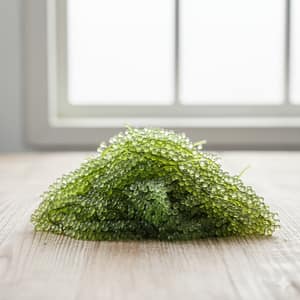- Home
- Sea Grapes / Green Caviar (Caulerpa lentillifera)

I. General Information
A. Scientific Name:
Caulerpa lentillifera
B. Alternative Names:
Sea grapes, Green caviar, Lato (Philippines), Umibudō (Japan)
C. Pronunciation:
See grayps / Oo-mee-boo-doh
II. Sourcing and Origin
A. Source:
Cultivated in tropical coastal regions, mainly the Philippines, Vietnam, and Okinawa.
B. Geographic Origin:
Philippines, Okinawa (Japan), Vietnam, Pacific Islands.
C. Method of Processing:
Harvested fresh, rinsed, and eaten raw.
III. Properties and Uses
A. Physical Properties:
Tiny grape-like beads
Bright green color
Crunchy texture
B. Chemical Composition:
Minerals: calcium, magnesium, iodine
Vitamins A and C
Dietary fiber
C. Primary Uses:
Skincare: Hydration in marine extracts.
Haircare: Mineral-rich for scalp health.
Wellness: Supports hydration and digestion.
Culinary: Eaten fresh in salads, sushi, and dipping sauces.
Household: Served as a delicacy at special gatherings.
D. Key Benefits:
Rich in vitamins and minerals
Refreshing, hydrating seaweed
Low-calorie superfood
IV. Safety and Considerations
A. Potential Allergies:
Rare, but may trigger iodine sensitivity.
B. Best Practices for Use:
Eat fresh with vinegar dips or in salads.
C. Special Precautions:
Should be consumed fresh; does not store long after harvest.
V. Fun & Educational Facts
A. Historical Context:
Traditionally enjoyed in Okinawa and widely consumed in the Philippines.
B. Did You Know?
Called “green caviar” for its bead-like appearance and pop-in-the-mouth texture.
C. DIY Recipe Idea:
Philippine lato salad with tomatoes and onions
Okinawan sea grapes with soy sauce dip
Sushi topping
